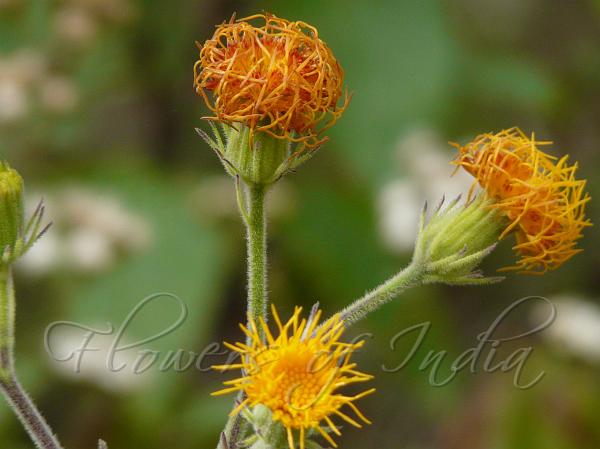|
| Nepal Gynura |
|

|

| File size | 545156 |
| Original date | 4/3/15 4:13 PM |
| Resolution | 2048 x 1536 |
| Flash | Flash did not fire, auto |
| Focal length | 77.9mm |
| Exposure time | 1/320s |
| Aperture | 4.0 |
| Focus Distance | |
| Metering Mode | Spot |
| Camera make | Panasonic |
| Camera model | DMC-FZ18 |
| Sensor type | OneChipColorArea |
|
|
|
|
Photo: |
Botanical name: Gynura nepalensis Family: Asteraceae (Sunflower family)
Synonyms: Gynura nudibasis, Cacalia nepalensis, Gynura foetens
Synonyms: Gynura nudibasis, Cacalia nepalensis, Gynura foetens
Nepal Gynura is a perennial herb with stems erect
or ascending, robust, 30-45 cm tall, woody at base, about 1 cm in
diameter, corymbosely branched in upper part, densely reddish-yellow
woolly. Stem leaves are numerous, absent on lower part of stem. Leaves
are stalked, not eared at base; blade narrowly elliptic, ovate, or
rhombic or oblong-lanceshaped, 3-20 x 1-6 cm, lateral veins 3-6-paired,
below velvet-hairy, above gray-white sparsely or densely reddish-yellow
velvet-hairy, base wedge-shapedly gradually narrowed to leaf-stalk,
margin entire or sawtoothed in upper half, rarely lobed, tip pointed or
tapering. Upper leaves are smaller, becoming bractlike, narrowly
lanceshaped-linear, stalkless. Flower-heads are numerous, about 1 cm in
diameter, usually in at branch-ends elongate lax corymbs.
Flower-head-stalks are 1-10 cm, with few linear bracts, densely shortly
velvet-hairy. Involucres bell-shaped, 10-13 × about 10 mm, with 7 or 8
linear calycular bracts, densely shortly velvet-hairy; phyllaries
uniseriate, 13 or 14, linear-lanceshaped, about 10 × 1.5-2.5 mm,
densely fulvous woolly or nearly hairless, sometimes stalkless
glandular hairy, margin scarious, apically tapering. Florets are
yellow; flower 8-10 mm; tube 4-5 mm, slender; limb dilated, lobes
triangular-ovate. Anthers blunt at base. Achenes are cylindric, 3-4 mm,
hairless or sparsely hairy, 10-ribbed. Pappus hairs numerous, white,
silky, easily deciduous. Nepal Gynura is found on rocks, field margins,
by streams in the Himalayas, at altitudes of 1100-2100 m, in Bhutan,
India, Kashmir, Myanmar, Nepal, Thailand.
Flowering: May-October.
Medicinal uses: The juice of the plant is
applied to cuts and wounds.
The juice of the plant is
applied to cuts and wounds.
Medicinal uses:
 The juice of the plant is
applied to cuts and wounds.
The juice of the plant is
applied to cuts and wounds. | Identification credit: Saroj Kasaju | Photographed in Naukuchiatal, Uttarakhand & Sourinee, Mirik, Darjeeling distt. |
• Is this flower misidentified? If yes,